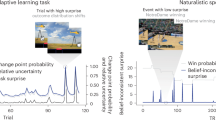Abstract
Humans and animals react in recognizable ways to surprising events. However, there is a lack of models that generate surprise intensity and its effects on behaviour in a realistic way, leading to impoverished and non-humanlike behaviour of agents in situations where humans would react surprised. To fill in this gap in agent-based modelling, a computational model is developed based on psychological empirical findings and theories from literature with which agents can display surprised behaviour. We tested this model in a simulated historical case from the domain of air combat and evaluated three behavioural properties against these simulated runs. The conclusion is that the model captures aspects of surprised behaviour and thus can help make agents behave more realistic in surprising situations.
Access this chapter
Tax calculation will be finalised at checkout
Purchases are for personal use only
Preview
Unable to display preview. Download preview PDF.
Similar content being viewed by others
References
Bosse, T., Jonker, C.M., Van der Meij, L., Sharpanskykh, A., Treur, J.: Specification and Verification of Dynamics in Agent Models. International Journal of Cooperative Information Systems 18, 167–193 (2009)
Ekman, P., Friesen, W.V.: Unmasking the face. Englewood Cliffs, Prentice-Hall (1975)
Futrell, R.F., et al.: Aces & Aerial Victories The United States Air force in Southeast Asia 1965-1973. The Albert F. Simpson Historical research center Air University (1976)
Gendolla, G.H.E., Koller, M.: Surprise and Motivation of Causal Search: How Are They Affected by Outcome Valence and Importance? Motivation and Emotion 25(4), 327–349 (2001)
Horstmann, G.: Latency and duration of the action interruption in surprise. Cognition and Emotion 20(2), 242–273 (2006)
Isby, D.C.: Fighter Combat in the Jet Age. HarperCollins Publishers, London (1997)
Macedo, L., Cardoso, A., Reisenzein, R.: A surprise-based agent architecture. In: Trappl, R. (ed.) Cybernetics and Systems, vol. 2. Austrian Society for Cybernetics Studies (2006)
Maguire, R., Keane, M.T.: Surprise: Disconfirmed Expectations or Representation-Fit? In: Proceedings of The 28th Annual Conference of the Cognitive Science Society, pp. 1765–1770 (2007)
Mann, L., Tan, C.: The Hassled Decision Maker: The Effects of Perceived Time Pressure on Information Processing in Decision Making. Australian Journal of Management 18, 2 (1993)
Michel, M.L.: Clashes: Air Combat over North Vietnam 1965-1972. US Naval Institute Press (1997)
Niederhauser, G.A.: Defeating surprise? Naval War College Newport, R. I. Report number AD-A279 463 (1994)
Plutchik, R.: Emotions: A general psychoevolutionary theory. In: Scherer, K.R., Ekman, P. (eds.) Approaches to emotion, pp. 197–219. Erlbaum, Hillsdale (1984)
Teigen, K.H., Keren, G.: Surprises: low probabilities or high contrasts? Cognition 87(2), 55–71 (2002) (March 2003)
Scherer, K.R.: Emotion as a multicomponent process: A model and some cross-cultural data. In: Shaver, P. (ed.) Review of personality and social psychology, pp. 37–63. Sage, Beverly Hills (1984)
Stiensmeier-Pelster, J., Martini, A., Reisenzein, R.: The role of surprise in the attribution process. Cognition and Emotion 9, 5–31 (1995)
Author information
Authors and Affiliations
Editor information
Editors and Affiliations
Rights and permissions
Copyright information
© 2010 Springer-Verlag Berlin Heidelberg
About this paper
Cite this paper
Merk, RJ. (2010). A Computational Model on Surprise and Its Effects on Agent Behaviour in Simulated Environments. In: Demazeau, Y., Dignum, F., Corchado, J.M., Pérez, J.B. (eds) Advances in Practical Applications of Agents and Multiagent Systems. Advances in Intelligent and Soft Computing, vol 70. Springer, Berlin, Heidelberg. https://doi.org/10.1007/978-3-642-12384-9_7
Download citation
DOI: https://doi.org/10.1007/978-3-642-12384-9_7
Publisher Name: Springer, Berlin, Heidelberg
Print ISBN: 978-3-642-12383-2
Online ISBN: 978-3-642-12384-9
eBook Packages: EngineeringEngineering (R0)




